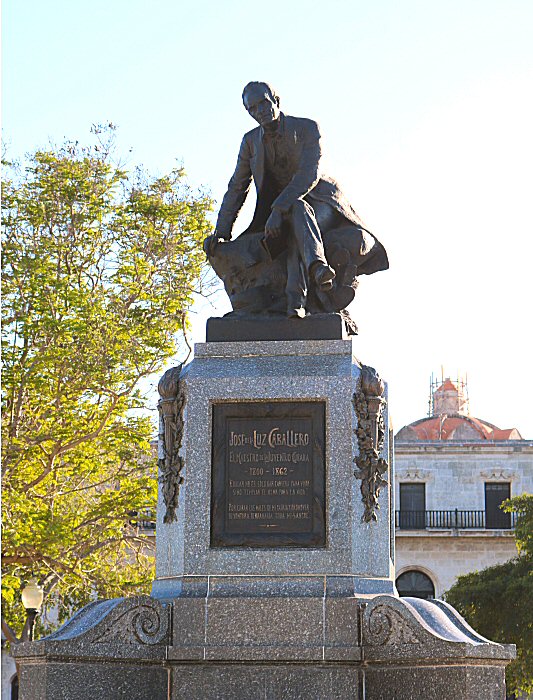
The area along the Malecón between the
Castillo de la Real Fuerza and the Parque Mártires del 71 is
occupied by a large green area that consists of Parque Luz y
Caballero and the Parque Céspedes that are divided by the Chacón
street. The Parque Luz y Caballero lies at the east part of this
green area, bordered by the Empedrado, the Tacón and the Chacón
streets and the Malecón (Avenue del Puerto).
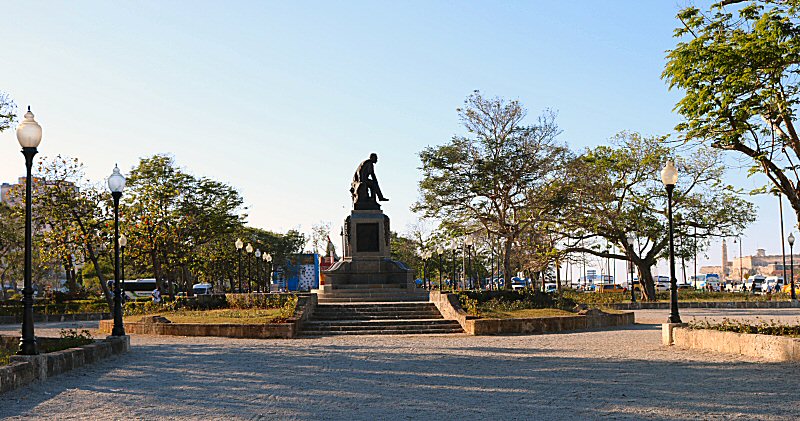
The Parque Luz y Caballero takes its
name from the prestigious pedagogue and philosopher José Cipriano Pío Joaquín de la Luz y Caballero (1800-1862) that had
a great contribution to the consolidation of the national
consciousness in the island. His bronze statue is placed on an
elevated round platform in the center of the park, in front of
the building of the former Colegio Seminario de San Carlos y San
Ambrosio (Seminary College of San Carlos and San Ambrosio) where
he graduated at the degree of Bachelor of Laws and worked as the
Director of the Chair of the Philosophy for many years. He is
represented sitting cross-legged on a rock, looking to the front
and thinking. His right hand holds a book, while he has a pen at
his left hand. On the dark granite pedestal it is written his
phrases: educar no es sólo dar carrera para vivir sino templar
el alma para la vida (to educate is not only to give a career to
live, but to temper the soul for life) and por curar los males
de mi patria y promover su ventura derramaría toda mi sangre (to
heal the evils of my homeland and promote their happiness, I
would shed all my blood). It is the work of the French architect
Charles Cousin and the French sculptor Julien Lorieux. It was
erected at the initiative of the Sociedad Económica de Amigos
del País (Economic Soeciety of Friends of the Country) in
memoriam of one of its former directors
in Parque de la Punta in 1913, and within the scope of the
project of beautification of the seashore and construction of
the Malecón, it was moved to the current location in 1926.
The park has a rectangular shape, lying
parallel to the coast, consisting of gardens and paths. At its
both ends there are the busts that belong to the prominent
figures of the Colegio Seminario de San Carlos y San Ambrosio
that had great contribution on the formation of national
identity in Cuba; the busts of Felix Varela y Morales and José
Antonio Saco y López Cisneros. The Cuban priest, writer,
philosopher and politician Felix Varela y Morales (1788-1853),
the first that taught Cubans to think about patriotism, had a
great influence on José de la Luz y Caballero. The sociologist,
journalist and historian
José Antonio Saco y López Cisneros (1797-1879) stood out
against slavery and the annexation of Cuba to the US.
Even though the excavation zone of the city wall makes the passage difficult, the Parque Luz y Caballero is at the transition point from the Malecón to the area around the Cathedral Square. Therefore, the park is surrounded by tourist busses, taxis, vintage cars and coaches.
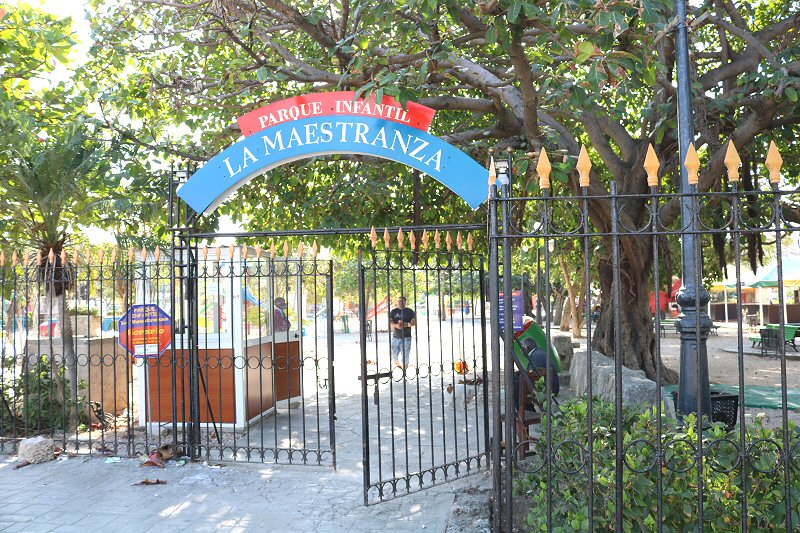 The west side of the green area along the Malecón is occupied by
the Céspedes park (or Parque de la Maestranza) that is used as a
children’s park (Parque Infantil). The children’s park is called
La Maestranza, referring to the Maestranza de Artillería that
was built to repair the artillery and casting of its pieces in
this area in 1843. In the time of the republic it housed the
Secretaries of State and Justice and later the National Library.
In 1938 it was demolished by Batista’s order to build the Police
Headquarters.
The west side of the green area along the Malecón is occupied by
the Céspedes park (or Parque de la Maestranza) that is used as a
children’s park (Parque Infantil). The children’s park is called
La Maestranza, referring to the Maestranza de Artillería that
was built to repair the artillery and casting of its pieces in
this area in 1843. In the time of the republic it housed the
Secretaries of State and Justice and later the National Library.
In 1938 it was demolished by Batista’s order to build the Police
Headquarters.
In front of the children’s park, there
are four bronze busts of four prestigious personalities that
made great works for Cuban people. These are in sequence: Alexis
Everett Fryre, Estaban Borrero Echeverria, Matthew Hanna and
Eduardo Yero Buduen.
Alexis Everett Fryre (1859-1936) is an
outstanding American pedagogue that obtained great prestige for
his educational work in Cuba. Estaban Borrero Echeverria
(1849-1906) is a Cuban professor, doctor and poet, one of the
great intellectuals in the history of Cuba. Matthew Hanna is an
American pedagogue that carried out the organization of public
education in Cuba after the cessation of Spanish rule. Eduardo
Yero Buduen (1852-1905) is a Cuban journalist and politician
that fought for independence of his homeland. The west side of the Céspedes Park is occupied by
an amphitheater. It was built by
the architect, civil engineer and pre-revolution
politician Luis Echarte Mazorra that also built the Casa de la
Tejas Verde in Miramar.
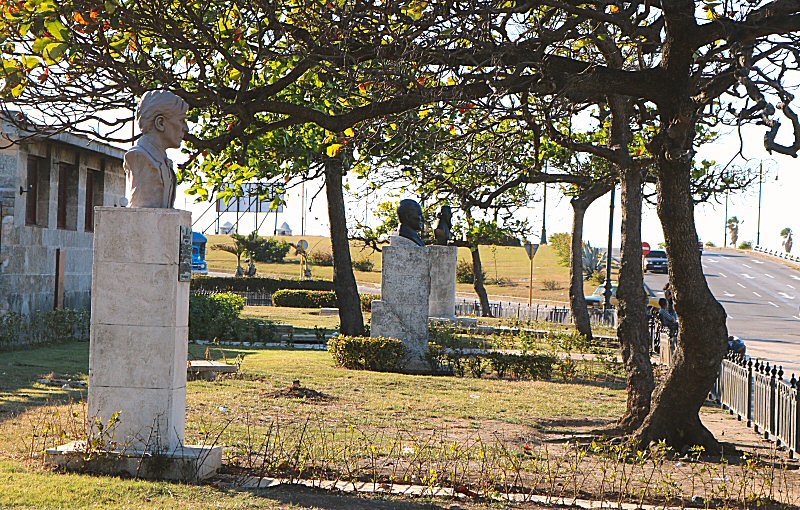 However, the most visited place by the tourists
is the Malecón side of the park where the statues of some
personalities are, such as Hasekura Tsunenaga Rokuemon, José
Carlos Mariátegui, Mustafa Kemal Atatürk, and Rabindranath
Tagore.
However, the most visited place by the tourists
is the Malecón side of the park where the statues of some
personalities are, such as Hasekura Tsunenaga Rokuemon, José
Carlos Mariátegui, Mustafa Kemal Atatürk, and Rabindranath
Tagore.
The bust of José Carlos Mariátegui is the third bust from the right after the busts of Mustafa Kemal Atatürk and Rabindranath Tagore, where the bust of Rabindranath Tagore is the first one.
José Carlos Mariátegui
(1894-1930) is a Peruvian journalist and philosopher that had a
great influence on the Latin American socialists. His work Siete
Ensayos de Interpretación de la Realidad Peruana (Seven
Interpretive Essays on Peruvian Reality), published in 1928, is
still widely read in the Latin American countries. He always
advocated that the revolution should evolve on the local
conditions and practices of the Latin American countries, and it
should be avoided to apply any formula strictly that was
successfull in other countries. He founded the Socialist Party
of Peru that later became the Communist Party of Peru, the
proletarian magazine Labor and the General Confederation of
Peruvian Workers. Mariátegui's writings concerning the role of
the indigenous peoples in the Latin American revolution, led to
the rise of popular indigenous movements in Ecuador and Peru. On
the other hand, Mariátegui’s phrase sendero luminoso al futuro (
the shining Path to the Future) became the source of inspiration
for the name of the Maoist communist group Shining Path. He died
of cancer at the age of 36.
One of his phrases is written on the
plaque on the pedestal of the bust: La revolución que será para
los pobres no solo será la conquista del pan, sino también la
conquista de la belleza, del arte del pensamiento y todos las
complaceneras del espíritu. (The revolution that will be for the
poor, will not only be the conquest of bread, but also the
conquest of beauty, the art of thought and all the pleasers of
the spirit.).
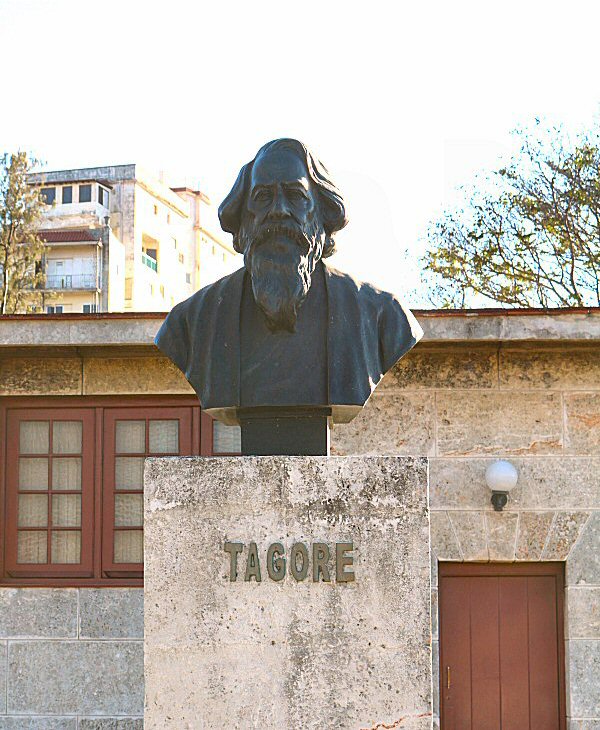
Rabindranath Tagore (1861-1941) is an Indian poet, musician, painter and narrator that was an active fighter for peace. He is considered the most important Hindu writer and one of the great humanists of the last century. He was the first non-European that won the Nobel Prize in Literature in 1913. Among his novels, stories, songs, dance-dramas, and essays, Gitanjali (Song Offerings), Gora (Fair-Faced) and Ghare-Baire (The Home and the World) are his best-known works. His compositions were chosen by two nations as national anthems: India's Jana Gana Mana and Bangladesh's Amar Shonar Bangla. Also, the Sri Lankan national anthem was inspired by his work.
